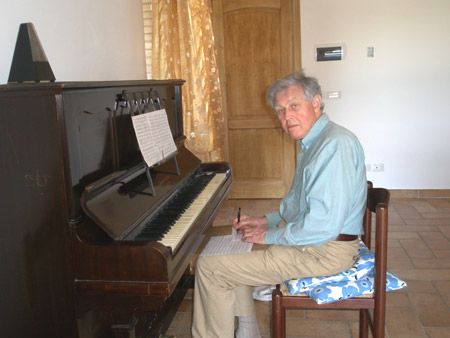 |
Return to previous page | david-matthews.co.uk |  |
|
|||||||
 |
|||||||
|
The news archive contains details of: 2010
|
World Premiere of Symphony No.7The world premiere of David's Seventh Symphony will be performed on 24 April 2010 by the BBC Philharmonic Orchestra conducted by Gianandrea Noseda at Bridgewater Hall, Manchester. When I received this commission for an orchestral piece to be played in the same concert as Mahler's Seventh Symphony, I couldn't resist writing a symphony too, which as it happened would be my own Seventh. Not that I imagined any kind of competition: for one thing the maximum length I was allowed was 20 minutes - the length of Mahler's first movement. If there was a symphonic model in my mind it was Sibelius's Seventh. I knew from the start that my own piece would also be in one movement, and that Sibelius's extraordinarily subtle transitions of tempo from slow to fast and back again would be an ideal to aim for. I also began - fortuitously, as it happened - in Sibelius's key of C major. What I did borrow from Mahler's Seventh was the 'Tenorhorn', which plays such a prominent part at the start of his first movement. This instrument is known in this country as 'baritone' - it is in fact a baritone saxhorn, and is a constituent of the brass band, but it has never become a regular orchestral instrument. I have always felt rather sorry for the player in Mahler's Seventh who falls silent after the first movement's recapitulation and is not required again. I don't know why Mahler did not allow him at least to join in the jubilation at the end of the finale. So I have written quite an extensive part, and found the instrument useful both as a kind of fifth horn and as a tenor tuba. Apart from this there are no unorthodoxies of scoring, and I use the percussion less than in my other symphonies with full orchestra, though the timpani play a major role, especially in a central cadenza.  David working on his Seventh Symphony in Umbria, Italy, May 2009 The Symphony opens with a long cantabile melody which is first given to the violas and passed in turn to the other strings. This melody was originally the culmination of a solo cello piece that I wrote in May 2008 for Gemma Rosefield. It was composed while on holiday in Crete, during mornings when I took refuge from the heat of the sun. I thought that I could reuse it as a melody for orchestral strings, and as a beginning instead of an ending. Exactly a year later I was on holiday in Umbria in equally sultry weather, and again spent a week of secluded mornings working on the big restatement of this melody later in the piece. Almost all the rest of the thematic material is derived from this melody, so its contours, will, I think, be quite familiar by the end. From the Allegro moderato opening the music moves to two faster sections, the second more obviously in scherzo character, leading eventually to a big climax and the timpani cadenza. The culmination of this cadenza is a stern chord with six drumbeats pounding through it, followed by a slow, questioning section marked 'Tenebroso'. This gradually moves out of darkness, through a brief reminiscence of the scherzo, to a full repeat of the opening section in D major. There is a lengthy coda, starting Allegro strepitoso, whose boisterous energy is eventually stabilised in an assertive D major ending. Because it is probably the most conclusive ending I have ever written, it seems to me like a summing up of all the symphonies I have written during the past 35 years. The Symphony was written between June 2008 and October 2009. It is dedicated to the BBC Philharmonic in gratitude for the many fine performances they have given of my music over many years. David Matthews |
||||||
 | |||||||
| Copyright on all site content held by David Matthews ©2025 | |||||||